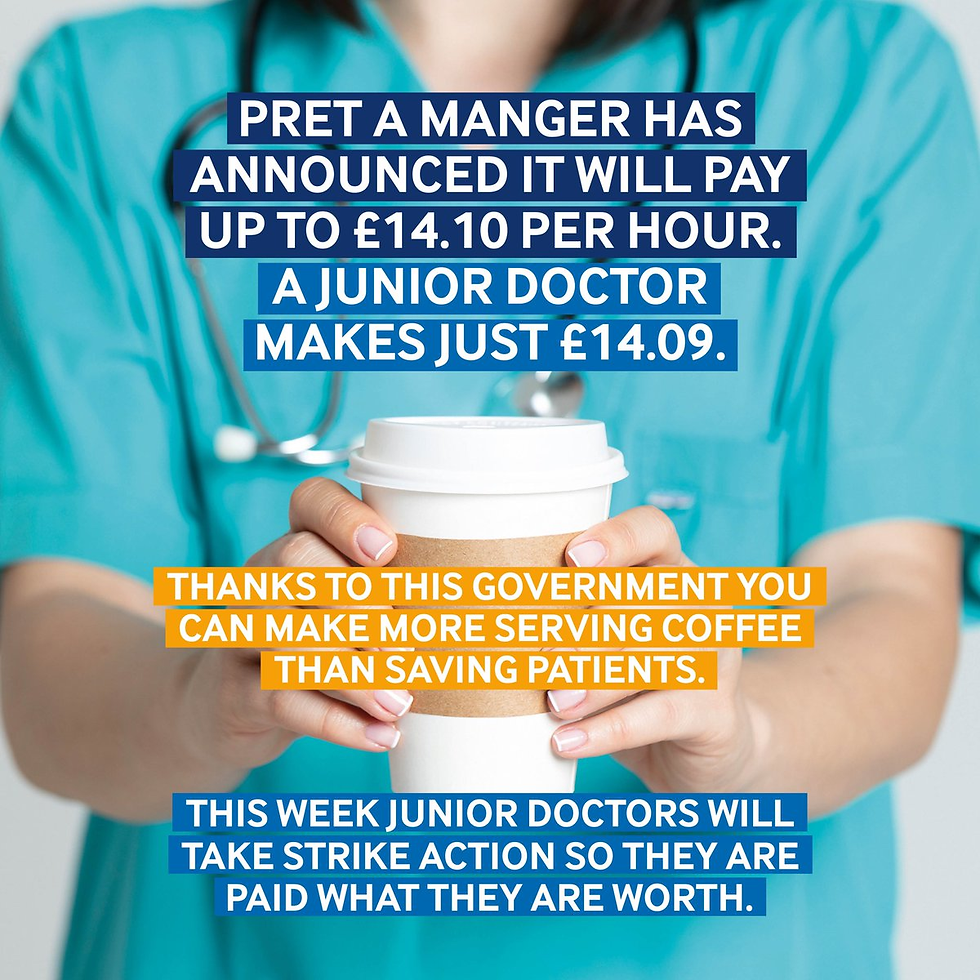What does the new junior doctor pay deal mean?
- Frances Weston
- Sep 24, 2024
- 4 min read
On the 13th of March, 2023, a one-year and six-month journey of strike action began for junior doctors, involving 11 individual rounds and totalling 44 days of strikes.
However, on 16th September 2024, these strikes have finally come to an end, with an agreement having been made between the British Medical Association (BMA) and new government.
So, let’s break down why doctors were striking, and what the new deal means.
Junior doctors have voted to accept a pay rise which will average 22% over two years, in a constructive step towards pay restoration.
The pay deal is a positive step forward for doctors, and a particularly positive change for myself and my colleagues, as after 8 years of studying, I am due to graduate as a doctor and start work next year.
Why were junior doctors striking?
Since 2008, junior doctors have had an approximate 35% decrease in salary, due to below-inflation pay rises.
The image below illustrates the current pay of junior doctors in 2024, and was captioned by the BMA: "The junior doctors operating on your appendix are paid just £66.55 between them. For a potentially life-saving procedure, which lasts about an hour". When a junior doctor with 1 year’s experience is referred to, this means they have already completed 4-7 years of medical training at university, and are in their first year of working as a doctor. The image highlights how a doctor with one year of experience is earning £14.09/hour, which has been compared to a rate less than that of a Pret A Manger Barista, whilst a trainee surgeon with 10 years of experience is earning £28/hour.
The BMA posted a photo further highlighting the junior doctor and Pret A Manger barista's similarity in salary, leaving many doctors feeling undervalued due to the years of training they have undergone, and the level of responsibility they hold for people's lives.
This salary decrease has taken place on a background of junior doctors experiencing workplace burnout at the highest level ever recorded, high-pressure workloads, inadequate resources, poor support structures, and a cost-of-living crisis. In fact, junior doctors are now facing higher levels of burnout than during the pandemic, with 63% of doctors feeling ‘at a high or moderate risk of burnout. I have written previously about burnout in the NHS which you can read more about here.
Additionally, 65% of doctors have experienced the feeling of ‘moral distress’ as a result of working in the NHS. Moral distress refers to the psychological unease felt when professionals identify an ethically correct action to take but are constrained in their ability to take that action.
It is therefore unsurprising that 19,000 doctors were estimated to have left NHS England prematurely between September 2022 and 2023. This equates to 1 in 7 of the NHS doctors in the workforce.
Doctors enter the profession wanting to help people, however when resources don’t allow for this, it is devastating. When you then also feel undervalued due to factors such as a salary decrease, it exacerbates the challenges already faced by doctors.
Therefore, the strike action was called to advocate for pay restoration, and one and a half years on, a new pay deal has been accepted.
What does the new pay deal mean?
The pay deal offers an average of a 22% pay increase over two years, which results in an average 4.05% uplift on existing 2023/24 junior doctor pay. For a first-year doctor, this will result in earning approximately £16.06/hour compared to the previous £14.10/hour. This offer shows progression in the journey to reverse the past decrease, and moves doctors about one third of the way towards full pay restoration.
The new deal will hopefully provide a renewed sense of optimism for doctors, and a belief that a more positive work environment can be achieved.
What about other healthcare professionals?
Some frustration has arisen for other healthcare professionals such as nurses, midwives and physios, some of which similarly underwent strike action last year. After the Royal College of Nursing’s (RCN) negotiations with the prior government, their pay deal was a little more than half of the new junior doctor deal as a percentage increase.
The leader of the RCN has said “We do not begrudge doctors their pay rise”, “What we ask for is the same fair treatment from government.” The RCN has now opened up communication with its members to understand the views of nursing staff on their current pay, which is yet to be announced.
What other changes are happening alongside the doctor pay deal?
The junior doctor pay deal announcement also comes alongside a change to the title of doctors, with junior doctor being removed and replaced by the term resident doctors.
Over the course of the pay dispute, there have been large amounts of misinformation and confusion over the term junior doctor. The previous governments Health Secretary, Victoria Atkins, was accused of belittling Junior Doctors by calling them “doctors in training” on national television. This may suggest to some that they are not qualified doctors, or are undergraduate students.
However, the definition of a junior doctor is ‘a qualified doctor practicing at any stage between graduation and completion of specialist postgraduate training’. Junior doctors could have a decade of experience working in a field such as neurosurgery, however, have not yet finished training due to the length of time it takes to complete. Therefore, the new term 'resident doctor' will be a positive change to better reflect the skills and responsibilities of these doctors.
Overall, the pay deal is a step towards pay restoration and will hopefully provide positive news to doctors working on the frontline, alongside the change in terminology from junior to resident doctor.




